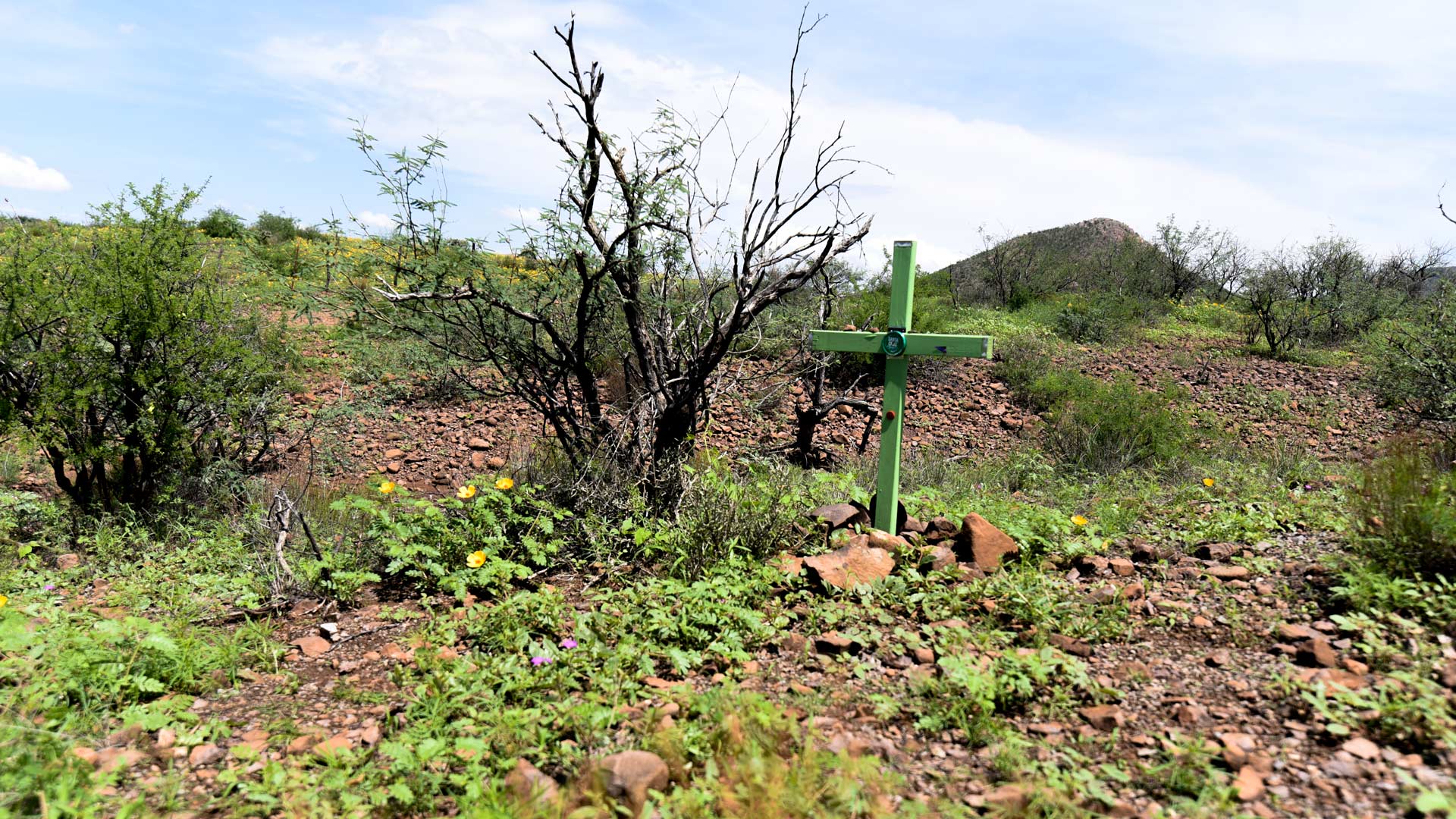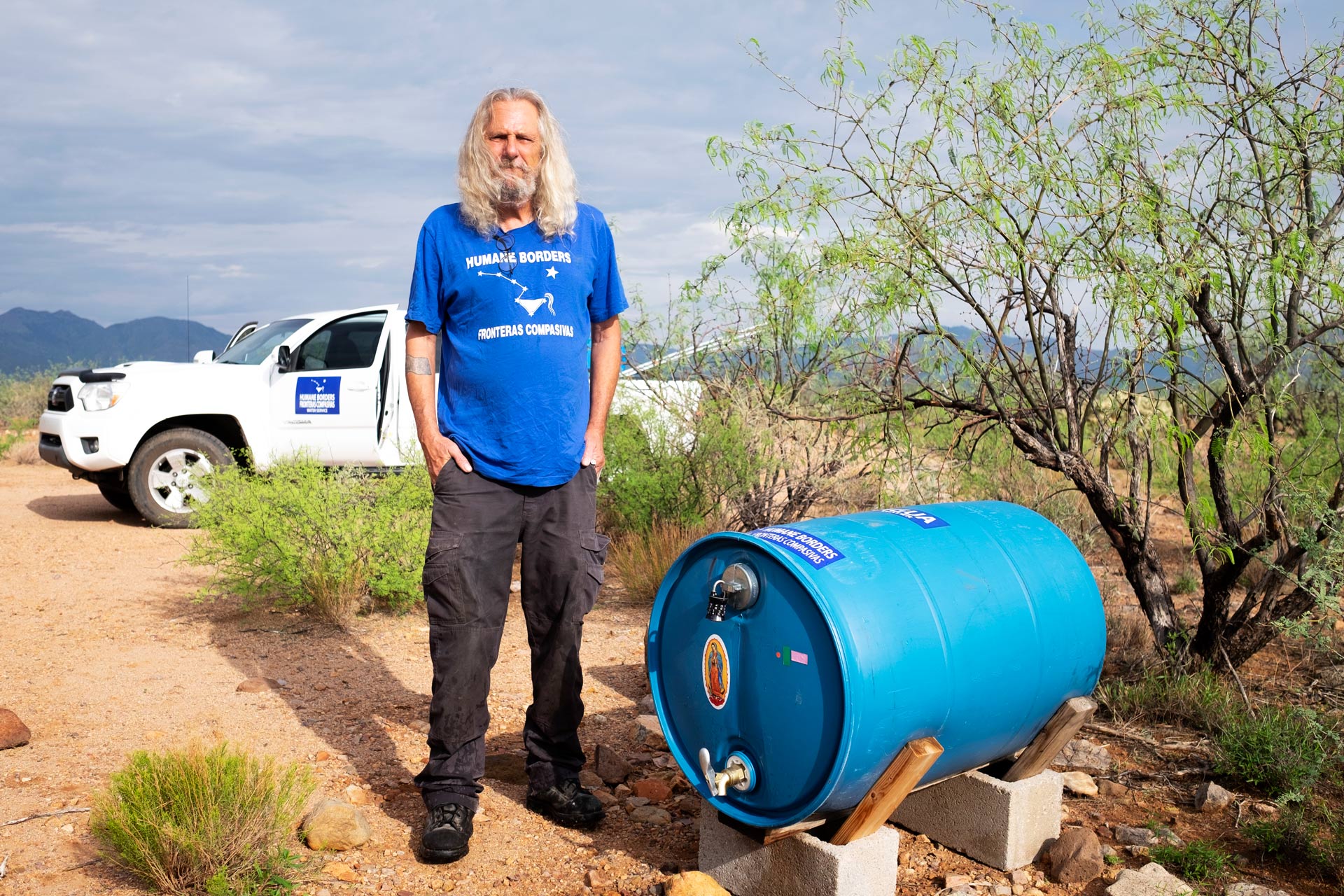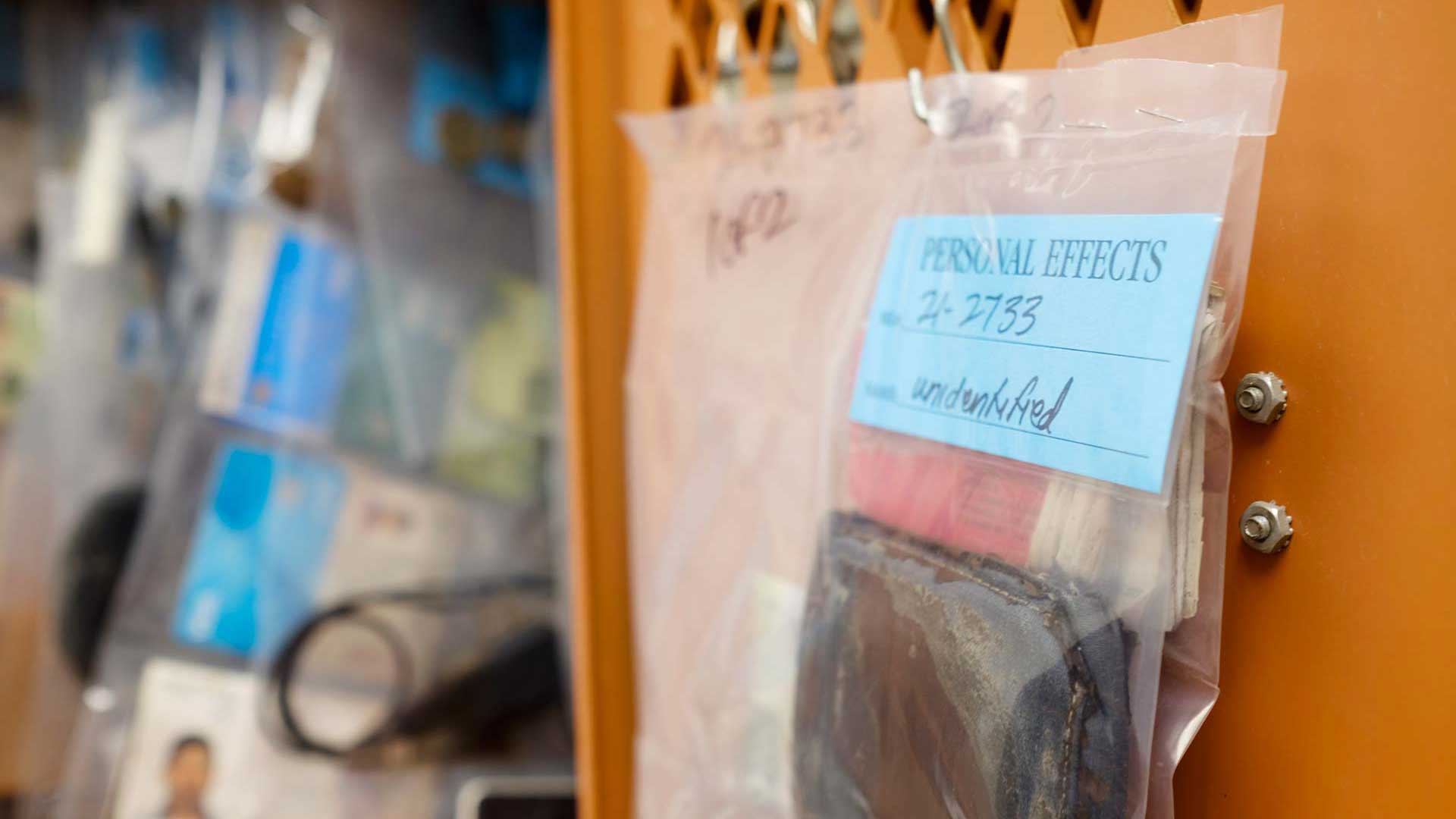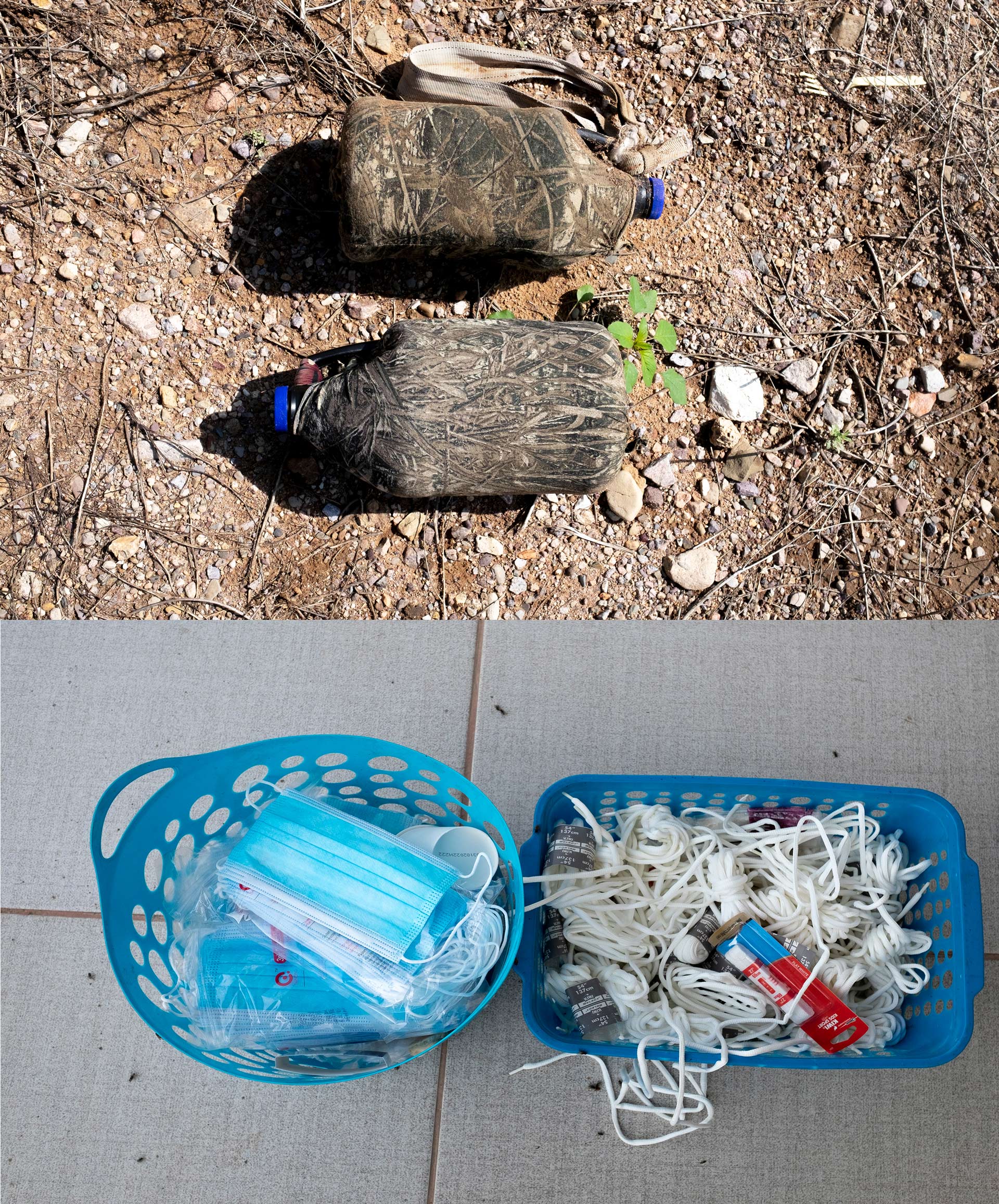 Since the year 2000, the Pima County Medical Examiner has received nearly 4,000 sets of human remains from people who died crossing the U.S.-Mexico border into Arizona. Here, a cross marking the place where a man in his 30s died in 2009 lays a few hundred yards from one of the water stations the nonprofit Humane Borders sets out for migrants crossing the desert.
Since the year 2000, the Pima County Medical Examiner has received nearly 4,000 sets of human remains from people who died crossing the U.S.-Mexico border into Arizona. Here, a cross marking the place where a man in his 30s died in 2009 lays a few hundred yards from one of the water stations the nonprofit Humane Borders sets out for migrants crossing the desert.
I’m standing in an empty stretch of desert grassland just outside Arivaca, about ten miles from the Arizona-Sonora border.
Joel Smith has brought me here to point out a squat wooden cross that marks the place where a man in his 30s died trying to cross that border and make it to the U.S.
"You just don’t know his final moments, did he mention his wife’s name? His kids? A lover? You just don’t know," he said. "You know, sometimes we forget these people are human. He was somebody's son."
Smith is a Marine veteran with blue eyes and shoulder-length grey hair. He comes to the desert most days of the week to check on barrels of water he helps maintain as a staff member of an aid group called Humane Borders.
 VIEW LARGER Joel Smith with Humane Borders helps maintain around 50 water stations around Arizona’s borderland.
VIEW LARGER Joel Smith with Humane Borders helps maintain around 50 water stations around Arizona’s borderland. He hopes the water will save someone’s life. Though, one of his stations is just a few hundred yards from the cross we're standing in front of now. He keeps his eyes peeled for those who don’t make it.
"We think there’s a lot of dead migrants out there, that nobody will ever find," he said. "And eventually their bones will be scattered by the wild animals, and they’ll decompose out there."
The remains that are found across roughly 260 miles of Arizona borderland go to Pima County Medical Examiner Greg Hess.
On a Monday morning, Hess takes me to a windowless back room at his office with orange lockers that are filled with the belongings of migrants who died. More than 3,400 sets of remains have been brought to his office over the last two decades.
There's one locker for 2018, 2019 and 2020. He's already expanded to two lockers for 2021.
"What we have in this plastic sleeve is a wallet," he says, "We’ve pulled out a couple of identification cards for -- they’re Mexican identification cards. We've got some pieces of paper with phone numbers, a cell phone."
 Lockers at the Pima County Medical Examiner’s Office contain belongings recovered alongside migrants who died in the desert. Death investigators use the items to help determine the person’s identity, and return their remains to family.
Lockers at the Pima County Medical Examiner’s Office contain belongings recovered alongside migrants who died in the desert. Death investigators use the items to help determine the person’s identity, and return their remains to family.
Last year, 220 sets of remains were brought to him, some of which are still being analyzed and, in some cases, matched to remains discovered in previous years. It was a 10-year high that Hess says his office is on pace to surpass this year.
In June of 2021 alone, during the brutal heat wave, he received 43 bodies and skeletal remains. Not all died in June, but most were found days after they succumbed.
 VIEW LARGER Pima County Medical Examiner Greg Hess says his office has received the remains of more than 3,400 migrants who died in Arizona over the last two decades. Just over 1,000 are still unidentified.
VIEW LARGER Pima County Medical Examiner Greg Hess says his office has received the remains of more than 3,400 migrants who died in Arizona over the last two decades. Just over 1,000 are still unidentified. "The majority of the remains that we recover we’re either calling the cause of death environmental related like hyperthermia, dehydration or a combination of those things," he said.
Border Patrol Agent Jesus Vasavilbaso says the Tucson Sector was getting up to 40 calls to 911 each day during June’s heat wave.
"We have seen an increase in encounters overall," he said. "So the more people that come, obviously, the more people that they're going to be asking to be rescued."
Customs and Border Protection data shows border-wide encounters, or apprehensions, are the highest they’ve been in 15 years.
But analysts also point out another reason for the spike is the fact that Border Patrol agents are catching the same people multiple times thanks to Title 42, the public health protocol enacted by the Trump administration at the onset of the pandemic in March of last year. The policy allows border officers to turn most migrants back to Mexico almost immediately. More than 900,000 removals have occurred since the policy took effect.
The Biden administration has continued to use Title 42 despite pressure from human rights groups, who say it traps migrants into resource-strapped border towns and can make claiming asylum impossible.
But the policy also basically erases the threat of criminal penalties for crossing illegally.
"As a result, many people have been incentivized to make repeat crossings," said Aaron Reichlin-Melnick, policy counsel with the American Immigration Council, which advocates for immigrants.
 VIEW LARGER Top image: A pair of water bottles encased in cameo sleeves are recovered along a stretch of highway south of Tucson by Joel Smith in July, 2021. These vessels are typically carried by migrants crossing in Arizona. Lower image: Baskets containing shoe laces and disposable masks sit at an aid station in Agua Prieta, just across the border from Douglas, Arizona. Aid workers provide both to migrants being returned to Mexico under Title 42, who are released by the Border Patrol without shoe laces.
VIEW LARGER Top image: A pair of water bottles encased in cameo sleeves are recovered along a stretch of highway south of Tucson by Joel Smith in July, 2021. These vessels are typically carried by migrants crossing in Arizona. Lower image: Baskets containing shoe laces and disposable masks sit at an aid station in Agua Prieta, just across the border from Douglas, Arizona. Aid workers provide both to migrants being returned to Mexico under Title 42, who are released by the Border Patrol without shoe laces. Reichlin-Melnick says as migrants keep trying to make the dangerous desert trek, the risks keep increasing.
"They try again 48 hours later, each time, they are rolling the dice," he said "And for some, because it has forced them to go into more dangerous locations, the journey ends in death."
CBP data shows that more than 30% of people apprehended border-wide in June were on at least their second crossing in a year. It’s more than double the average rate for many years pre-pandemic.
Norberto, who’d only give his first name, has tried five times.
One early morning in Agua Prieta, Sonora, just across the border from Douglas, Arizona, he and about 40 other migrants got off a Department of Homeland Security bus at the border crossing.
Agents caught Norberto in the desert. He looked for a pair of shoes in a few donated sets volunteers laid out.
He was still limping after a hard landing jumping the border wall. But he wanted the new shoes to cross yet again. His sixth try. I asked if he was scared to try again.
"Scared? Yes, but I have God, who protects us all," he said.
A version of this story originally aired on NPR, listen here.

By submitting your comments, you hereby give AZPM the right to post your comments and potentially use them in any other form of media operated by this institution.